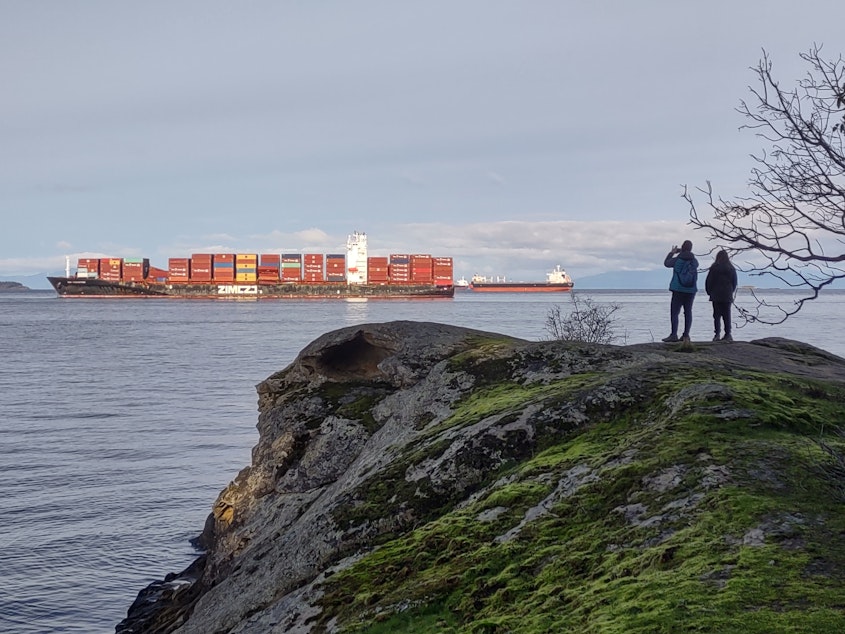Battered ship finds a port. 105 of its cargo containers presumed sunk

The ship that spilled more than a hundred cargo containers off the Washington coast, then caught fire has made it safely into port.
The same cannot be said for much of the Zim Kingston’s cargo.
Two months after it left Busan, South Korea, the Zim Kingston docked on Saturday at the Port of Nanaimo on Canada’s Vancouver Island.
Workers began the delicate work of offloading at least 58 damaged containers one by one.
Rough seas and a days-long fire had deformed the orderly stacks of “sea cans” into overhanging piles of crumpled steel.
After spilling an estimated 107 containers into the Pacific about 40 miles off the tip of the Olympic Peninsula on Oct. 22, the Zim Kingston headed to calmer waters. It set anchor in the Strait of Juan de Fuca, about 4 miles off of Victoria, British Columbia, and 15 miles from Port Angeles, Washington.
While at anchor, a row of damaged shipping containers caught fire. At least two more tumbled overboard.
Sponsored
Four containers washed up near the northern tip of Vancouver Island, scattering more than 30 tons of junk, including 71 refrigerators, on wilderness beaches near Cape Scott Provincial Park.
RELATED: Ship that spilled 100+ containers could have ridden out the storm in sheltered waters
But there’s been no sign of the other 105 containers that tumbled overboard. They are presumed to have sunk to the sea floor, most of them to the continental shelf, 450 to 600 feet beneath the surface of the Pacific.
Nanaimo harbor master Capt. Satinder Singh said he was excited to have the Zim Kingston at the Port of Nanaimo, which doesn’t normally handle such large vessels.
Sponsored
“This is an anomaly for us,” Singh said. “We are doing this because no other port was able to. The Port of Vancouver was too busy with other ships.”
Singh said the Zim Kingston would continue to “a suitable port” to offload its remaining estimated 1,800 containers.
Before the ship lost its containers, satellite tracking data reveals it had been zigzagging slowly in a holding pattern for about 20 hours on the open Pacific. Heavy seas from a major storm tilted the 850-foot vessel 35 degrees and sent containers tumbling from their tall stacks.
Though port congestion left the Zim Kingston waiting for a berth at the Port of Vancouver, the captain could have sailed it into the sheltered waters of the Strait of Juan de Fuca, as KUOW reported in October. Other ships awaiting safe spots to dock or anchor at the time were riding out the storm by doing slow loops on a 25-mile “race track” there.
Canada’s Transportation Safety Board has launched an investigation into the disaster. The agency says the inquiry could take up to 450 days to complete.
Sponsored
The fire was apparently caused by hazardous, spontaneously combustible cargo in at least two containers—including 57 tons of a mining chemical called potassium amyl xanthate. It emits a flammable gas on contact with water or water vapor.
While some of the remaining containers hold hazardous materials, Singh said they were far from the rows of damaged containers being offloaded.
“It’s the safest ship in Nanaimo right now, considering all the safety teams, all the salvage teams involved,” Singh said.
The Canadian Coast Guard and the ship’s owner, Danaos Shipping of Greece, are planning to do sonar surveys to locate the sunken cans.
“They will need to wait for a weather opportunity in order to conduct the scan,” Canadian Coast Guard spokesperson Michelle Imbeau said in an email.
Sponsored
Imbeau did not say whether Danaos will have to remove the sunken containers from the ocean.
Any attempts to salvage them won’t be easy.
Where the ship spilled its cargo, nautical charts show unexploded ammunition and underwater cables dotting the sea floor like confetti and streamers.
Though salvage gets more difficult and expensive in deeper water, heavy objects can be retrieved from profound ocean depths.
In March, the U.S. Navy recovered a sunken Sikorsky Seahawk helicopter off the coast of Japan under 19,075 feet or 3.6 miles of seawater.




